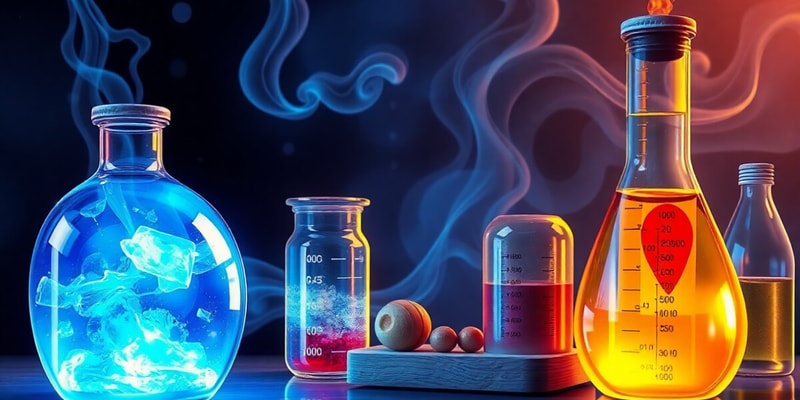Podcast
Questions and Answers
What formula is used to relate pressure, volume, temperature, and the amount of gas in moles?
What formula is used to relate pressure, volume, temperature, and the amount of gas in moles?
The formula is PV = nRT.
How do you convert the temperature from Celsius to Kelvin for use in the ideal gas law?
How do you convert the temperature from Celsius to Kelvin for use in the ideal gas law?
You add 273.15 to the Celsius temperature.
If the mole fraction of oxygen in air is 0.22, how do you calculate the number of moles of oxygen in 1 L of air?
If the mole fraction of oxygen in air is 0.22, how do you calculate the number of moles of oxygen in 1 L of air?
You multiply the mole fraction by the total number of moles present, calculated from PV = nRT.
What is the molecular mass of oxygen (O2), and how is it used in calculating mass from moles?
What is the molecular mass of oxygen (O2), and how is it used in calculating mass from moles?
Signup and view all the answers
What is the final mass of oxygen in grams found in 1.0 L of air under the conditions stated, and how is it derived?
What is the final mass of oxygen in grams found in 1.0 L of air under the conditions stated, and how is it derived?
Signup and view all the answers
Study Notes
Ideal gas law
- The ideal gas law is PV = nRT, which relates pressure (P), volume (V), number of moles (n), gas constant (R), and temperature (T).
- To find the number of moles (n), the equation can be rearranged to n = PV/RT.
- The value of the gas constant R is 0.082 L atm mol-1 K-1.
Conversion of Temperature
- The temperature needs to be converted from Celsius (°C) to Kelvin (K) using the formula : K = °C + 273.15.
- Given a temperature of 20°C , the conversion to Kelvin is 20°C + 273.15 = 293.15 K.
Calculation of Moles
- The moles of air (n) in 1.0 L at 1.0 atm and 293.15 K can be calculated using the rearranged ideal gas law:
- n = PV/RT = (1.0 atm)(1.0 L) / (293.15 K)(0.082 L atm mol-1 K-1) = 0.042 mol
Mole fraction of oxygen
- The mole fraction of oxygen (O2) in air is 0.22, meaning 22% of the moles in the air sample are oxygen.
- The moles of oxygen (n(O2)) can be calculated by multiplying the total moles of air by the mole fraction of oxygen:
- n(O2) = 0.22 x 0.042 mol = 0.00924 mol
Mass of oxygen
- The mass of oxygen (O2) can be calculated by multiplying the moles of oxygen by the molecular mass of oxygen (32 g mol-1).
- Mass O2 = 32 g mol-1 x 0.00924 mol = 0.296 g
Studying That Suits You
Use AI to generate personalized quizzes and flashcards to suit your learning preferences.
Related Documents
Description
This quiz covers the ideal gas law, including its formula PV = nRT and the calculation of moles from given conditions. It also explores temperature conversion from Celsius to Kelvin and the mole fraction of oxygen in air. Test your understanding of gas behavior and basic chemical calculations!



